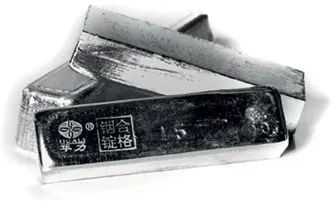Indium Prices
The current price of Indium is $761.50 per kg.
Please note that the price provided is the retail price for private investors and is aligned with industry retail pricing. For bulk purchases, whether investment or industry, please contact us for a quotation.
Table: Indium Historical Prices and Price Changes
| Date | Indium Price | Change % to Today | Annual Change % |
|---|---|---|---|
| Jul 11 2025 | $761.50 / kg | ||
| Jan 1 2025 | $698.80 / kg | +8.97% | |
| Jan 1 2024 | $561.60 / kg | +35.59% | +23.18% |
| Jan 1 2023 | $442.30 / kg | +72.17% | +26.97% |
| Jan 1 2022 | $477.10 / kg | +59.61% | -7.26% |
| Jan 1 2021 | $315.10 / kg | +141.67% | +51.41% |
| Jan 1 2020 | $315.11 / kg | +141.66% | 0.00% |
| Jan 1 2019 | $428.61 / kg | +77.67% | -26.48% |
| Jan 1 2018 | $380.10 / kg | +100.34% | +12.76% |
Indium Historical Price Movement
At today’s price of $761.50 per kg, indium has changed +8.97% since the start of 2025. It gained 23.18% last year and is up +72.17% since Jan 1st 2023.
This strategic metal increased +141.67% in value since Jan 1st 2021 when the cost of indium was $315.11 per kg. If we go back to Jan 1st 2018, when the price of indium was $380.10 per kg, the value increased by +100.34%.
Indium is a rare, malleable, and easily workable metallic element with the atomic number 49 and the symbol In. It has a silvery-lustrous gray appearance and is considered one of the least abundant elements in earth’s crust.
Uncovering the various applications of indium and who produces it first helps us predict its future price more accurately (jump to the forecast).
Indium Uses

Indium is an essential and versatile element with various uses across many industries. Indium has put its unique properties to work in consumer electronics, industrial manufacturing, mining exploration, medical technology, metallurgy, and transportation.
This rare metal is remarkably malleable for its density, which with its low melting point, makes it useful for soldering applications, such as microelectronics. Aerospace engineering and automotive manufacturing successfully use indium alloys.
Indium is also responsible for making glass transparent to certain light wavelengths, which makes it useful in LCD televisions, night-vision goggles, and other related technologies. Solar cells and smartphone displays also use indium sulfide.
Its natural lubrication benefits make indium salts a viable option for cosmetics and protective coating for aircraft components. Its thermal properties also make it ideal for use in refrigerators and other cooling systems.
Regarding medical applications, Indium-111 can be labeled with technetium-99m to help diagnose certain diseases in the body’s organs. Indium also plays an important part in cancer treatment because it can be inserted directly into tumors with radiation due to its low cost compared to alternative isotopes. Moreover, indium is biocompatible in many cases, making it useful for medical implants to prevent tissue invasion of foreign elements.
Its low reactivity makes indium an ideal choice as an inert atmosphere filler; its low vapor pressure also makes it a great preservative agent in vacuum systems or gas lines. Due to its softness and compressibility, indium is ideal for creating robust hermetic seals between metals or non-metallics like glass and ceramics. For example, indium can seal non-wettable surfaces in cryogenic applications, vacuum pumps, and heat-sensitive areas.
Where is Indium Produced?
Although a trace element found in many sources, indium is sourced mainly from zinc ores, which contain as little as 0.1 % of this rare element. The raw indium is separated from other metals using chemical processes, like liquidation and solvent extraction, and processed into a form suitable for use in industrial applications.
Today indium is mined in a number of countries around the world, such as China, Japan, Canada, Peru, and Mexico. According to STATISTA, approximately 66% of indium came from primary sources in China in 2023.

What Factors Determine the Price of Indium?
Simply put, the law of supply and demand determines the price of indium (like it does with other commodities).
Indium has become a key asset for many industries. Increased demand for end products from those industries (e.g., smartphones, aircraft, or solar cells) would increase the demand for this prized commodity.
In terms of supply, indium is considered rare when considering its availability on earth. It makes up just one part per million of the earth’s crust, making it much less abundant than more common elements such as copper and aluminum.
Indium Price Forecast
With its unique blend of strength and flexibility, indium continues to be a cornerstone in various industries, including photovoltaics, consumer electronics, aerospace, medical devices, automotive manufacturing, and LCD production. The burgeoning middle classes in emerging economies like China and India are driving increased demand for these products, thereby bolstering the need for indium.
Its unique properties also mean that indium has many new yet undefined applications. Due to this, predicting long-term demand for indium is difficult as the possible industries using it have yet to be definitively known.
In 2023, the worldwide production of indium was only 990 metric tons. China led this production with an output of about 650 metric tons, underscoring its dominant role in the indium supply chain. After meeting its domestic requirements, China essentially controls the volume available for export. This influence was evident in August 2023 when China imposed export bans on gallium and germanium, resulting in price surges for these essential materials. Indium has already been on the “Critical Raw Materials List” in both the US (since 2018) and Europe (since 2020).
Last year indium prices have surged by 23% since the beginning of the year, following a 27% increase in 2023. This upward trend reflects ongoing supply constraints and robust demand across various sectors.
Looking ahead, Donald Trump’s second term introduces significant uncertainties for the indium market. Known for his aggressive trade policies, Trump has historically used tariffs and trade restrictions as tools to counterbalance China’s dominance in critical sectors. Such measures led to market volatility, inflationary pressures, and disruptions across global supply chains during his first term.
China didn’t even wait for his inauguration to ban exports of gallium and germanium to the US. Should trade restrictions escalate, the resulting supply constraints could drive indium prices further upward, making it an even more critical resource for industries reliant on its unique properties.
In summary, the indium market and prices are forecast for continued growth, driven by escalating demand and constrained supply. Geopolitical developments, particularly Trump’s administration’s trade policies, may introduce additional volatility. Indium should be a valuable hard asset in a mixed rare earths & technology metals portfolio in the medium and long term.
How and Where to Buy Indium
Businesses like Apple, Samsung, Boeing, and Tesla turn to globally licensed market metals dealers when they require indium. These trusted intermediaries are the connecting link between high-tech industries and the producers of rare earths & strategic metals that enable them to produce innovative results.
You can also purchase smaller amounts of this valuable metal through online platforms such as eBay, Alibaba, or Amazon. However, this is only a viable solution for hobbyists rather than for industry or investors.
Reputable metals dealers like ourselves offer full chain-of-custody verification guaranteeing quality purity (min. 99.995%). We also facilitate storage under ideal industrial conditions so discerning investors can ensure long-term security and success when buying this precious material as an investment.
Indium futures contracts are traded in the Shanghai Metal Market (SMM) too.
How and Where to Sell Indium
The only viable option for those wishing to offload industrial-grade indium is to use reputable industry suppliers. That’s because only they can provide the chain of custody documents and analysis reports needed by serious buyers like LG, General Motors, Hisense, and Honda.
If you bought some indium on an online marketplace, you’re only option is to sell it again to some other enthusiast on eBay, Amazon, or Alibaba. You will unlikely get market rates, making it challenging to realize profits from future price gains.
On the other hand, we can guarantee the safe and fast liquidation of the strategic metals of our investors at market rates because we’re an industry supplier.
All prices on this page last updated Jul 11 2025.


